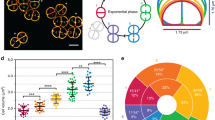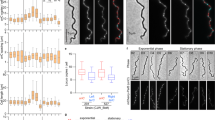Abstract
DIMIDIUM bromide (2 : 7-diamino-9-phenyl-10-methyl phenanthridinium bromide) is a trypanocidal phenanthridinium compound which has been shown to effect nucleic acid synthesis in various organisms; for example, flagellate protozoa, bacteria, yeasts and tissue culture cells1. Growth of the free-living amoebae, Amoeba proteus and Amoeba discoides, is inhibited by this drug, the cells showing a characteristic response which depends on the concentration of drug used2. In concentrations of dimidium bromide below 1 µg/ml., cells of both strains of amoebae divide three times before inhibition and death. In concentrations of dimidium bromide between 4 and 8 µg/ml., both strains divide only twice before death. There is a difference in the response of the two strains in concentrations of drug between 2 and 4 µg/ml.; A. proteus divides twice while A. discoides undergoes an additional cycle of division before inhibition and death. This difference is thought to be associated with the presence in the cytoplasm of our strain of A. discoides of “bodies” containing DNA and RNA2–4. Similar results have been obtained using the 10-ethyl analogue ethidium bromide.
This is a preview of subscription content, access via your institution
Access options
Subscribe to this journal
Receive 51 print issues and online access
$199.00 per year
only $3.90 per issue
Buy this article
- Purchase on Springer Link
- Instant access to full article PDF
Prices may be subject to local taxes which are calculated during checkout
Similar content being viewed by others
References
Newton, B. A., Adv. Chemother., 1, 42 (1964).
Hawkins, S. E., and Willis, L. R., J. Cell Sci. (in the press).
Wolstenholme, D., Nature, 211, 652 (1966).
Hawkins, S. E., and Wolstenholme, D., Nature, 214, 928 (1967).
Lorch, I. J., and Danielli, J. F., Quart. J. Microsc. Sci., 94, 445 (1953).
Lorch, I. J., and Danielli, J. F., Quart. J. Microsc. Sci., 94, 461 (1953).
Lerman, L. S., J. Cell Comp. Physiol., 64, Suppl. 1, 1 (1964).
Elliott, W. H., Biochem. J., 86, 562 (1963).
Waring, M. J., Mol. Pharmacol., 1, 1 (1965).
Newton, B. A., J. Gen. Microbiol., 17, 718 (1957).
Waring, M. J., J. Mol. Biol., 13, 269 (1965).
Ormerod, W. E., Brit. J. Pharmacol. Chemother., 6, 334 (1951).
Ormerod, W. E., and Shaw, J. J., Brit. J. Pharmacol. Chemother., 21, 259 (1963).
Ord, M. J., J. Cell Sci., 3, 81 (1968).
Goldstein, L., and Prescott, D., J. Cell Biol., 33, 637 (1967).
Goldstein, L., and Prescott, D., J. Cell Biol., 36, 53 (1968).
Author information
Authors and Affiliations
Rights and permissions
About this article
Cite this article
HAWKINS, S., WILLIS, L. Nuclear Transplantation Studies of the Action of Dimidium Bromide on Amoebae. Nature 222, 86–87 (1969). https://doi.org/10.1038/222086a0
Received:
Issue Date:
DOI: https://doi.org/10.1038/222086a0
Comments
By submitting a comment you agree to abide by our Terms and Community Guidelines. If you find something abusive or that does not comply with our terms or guidelines please flag it as inappropriate.



